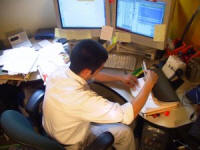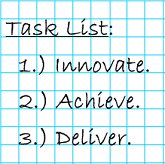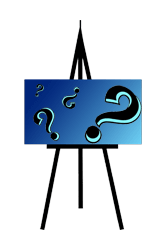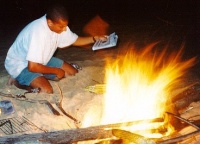 There is a palpable pressure in society to be “perfect.” We praise people who are efficient. From an early age we learn to do things well. Perfection is a worthy ideal and we should always aim to improve ourselves. Perfection, as such, through extreme efficiency can be a double-edged sword. It’s worthwhile to consider:
There is a palpable pressure in society to be “perfect.” We praise people who are efficient. From an early age we learn to do things well. Perfection is a worthy ideal and we should always aim to improve ourselves. Perfection, as such, through extreme efficiency can be a double-edged sword. It’s worthwhile to consider:
Is what I am doing in this instant efficient or effective?
The definitions in the dictionary of efficiency and effectiveness are very similar. Depending on your perspective, there are significant differences. In his essay “Effective versus Efficient Decisions”, Dr. Donald Burton offers this definition:
Efficiency – To do things right
Effectiveness – To do the right things
Let’s take a look at a couple of examples:
First, let’s suppose today is our first day of work for the year. We know our existing clients will play a fundamental role in successfully achieving our business plan. We look at our client files and find they are a mess. We decide to organize and analyze each file by creating an Excel program referencing the following items: who bought our product, why did they buy it and with whose approval, where was each product purchased, and at what time. To efficiently complete the task takes us two weeks working from 7:00 AM to 8:00 PM.
 Our boss and our colleagues are impressed by our “efficiency.” The hyperlinks between documents and the color coded graphs with each color representing one of our clients will be very useful. During these same two weeks, while we have been “efficient,” a new competitor has been more “effective” and has set meetings with each of our clients to sell them a new product, which we also will be launching. Being effective and doing the right thing is much more important than being efficient.
Our boss and our colleagues are impressed by our “efficiency.” The hyperlinks between documents and the color coded graphs with each color representing one of our clients will be very useful. During these same two weeks, while we have been “efficient,” a new competitor has been more “effective” and has set meetings with each of our clients to sell them a new product, which we also will be launching. Being effective and doing the right thing is much more important than being efficient.
Now, imagine taking 10 minutes at the end of each day to make a list of to do’s for the following day. This habit is very “efficient” though not necessarily “effective.” The tasks we normally place on our list are those which have to be done and not necessarily those that should be done.
We obtain immense personal satisfaction, which is reinforced in the work place with congratulatory comments about a job well done. By its very nature, doing what should be done is more difficult because often it implies taking a risk and doing something we have never done before. In addition, it opens the door to possible failure. Our challenge is to be effective and efficient at the same time. We can make a list of to do’s which starts with what should be done and then with what has to be done. Effectiveness and efficiency are not mutually exclusive; they can work well together.
Great accomplishments have been made by paving new paths. The pleasure of being efficient in something we already know how to do is momentary. The delight of doing something we have never done before requires additional effort and can be extraordinary. We can be more effective by doing the right thing and thus determine our direction and our destiny.
It’s the Bounce that Counts!
∞ Rob McBride ∞
LL I 32


 The difference between achieving and dreaming is the specific action we take toward our objectives. We can create, imagine, innovate and desire but without taking concrete steps toward our intention, we are left high and dry.
The difference between achieving and dreaming is the specific action we take toward our objectives. We can create, imagine, innovate and desire but without taking concrete steps toward our intention, we are left high and dry.
 Preparation is also key factor to our achieving success when taking a leap of faith. When we are well prepared, does this still mean we are taking a leap of faith? While some may argue otherwise, making a decision which moves us out of our “comfort zone” always creates significant change. The distance we must leap is a function of our preparation. We can diminish the gap from where we currently stand and where we want to go with comprehensive analysis and preparation.
Preparation is also key factor to our achieving success when taking a leap of faith. When we are well prepared, does this still mean we are taking a leap of faith? While some may argue otherwise, making a decision which moves us out of our “comfort zone” always creates significant change. The distance we must leap is a function of our preparation. We can diminish the gap from where we currently stand and where we want to go with comprehensive analysis and preparation.

 ACHIEVE: To succeed in the sea of day to day events isn’t easy. Our lives can be likened to a ship on the ocean in the middle of a storm. The swirling winds of destiny and peril test our determination and purpose.
ACHIEVE: To succeed in the sea of day to day events isn’t easy. Our lives can be likened to a ship on the ocean in the middle of a storm. The swirling winds of destiny and peril test our determination and purpose.

 can look them straight in the eye and say:
can look them straight in the eye and say: From the day we enter this wonderful world until they day we depart to a reality yet unknown, we face problems and challenges.
From the day we enter this wonderful world until they day we depart to a reality yet unknown, we face problems and challenges.
 They are in fact one in the same! It’s a question of attitude and vision. What appears to be a problem without resolution today, often results in a challenge fostering growth and creativity.
They are in fact one in the same! It’s a question of attitude and vision. What appears to be a problem without resolution today, often results in a challenge fostering growth and creativity. Sometimes we are up and inspired; at other times we are down and uninspired.
Sometimes we are up and inspired; at other times we are down and uninspired. Inspiration and motivation create a flame which gives us warmth and sustenance, as it did for our ancestors thousands of years ago.
Inspiration and motivation create a flame which gives us warmth and sustenance, as it did for our ancestors thousands of years ago.


 Communication is the only tool we have to understand others and to express our ideas. Unfortunately, it tends to be a skill we learn only by trial and error and not through formal schooling. The art of effective communication is seldom part of our educational curriculum.
Communication is the only tool we have to understand others and to express our ideas. Unfortunately, it tends to be a skill we learn only by trial and error and not through formal schooling. The art of effective communication is seldom part of our educational curriculum.